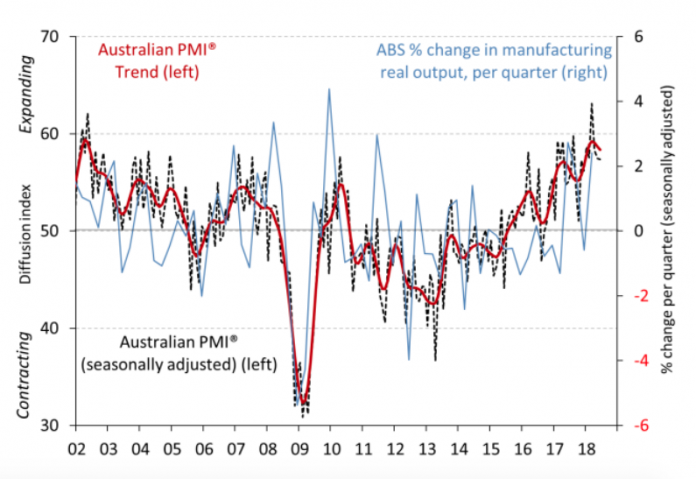
The Australian Industry Group Australian Performance of Manufacturing Index (Australian PMI) ended the financial year in a strong position, having posted its 21st month of continuous expansion in June.
Despite going down 0.1 point on the prior month to a total of 57.4 points in June, the result means that the Australian PMI is enjoying its longest run of expansion in well over a decade, with the longest positive run being 50 continuous months from July 2001 to July 2005.
According to Ai Group’s report, six of the seven activity sub-indexes in the Australian PMI expanded in June, with the new orders sub-index defying an end-of-year reduction in new orders to remain solidly positive at 57.6 points. Sales also grew strongly and went up 10.8 points to 61.2.
Employment continued its purple patch that began in December 2016 and went up 2.0 points to 58.1 in June, building on the manufacturing jobs growth shown by ABS employment data.
The survey has also found that seven of the eight manufacturing sub-sectors expanded in June, with the textiles, clothing, furniture & ‘other’ manufacturing sub-sector’s stable conditions the only exception (down 1.0 point to 49.3).
Sub-sectors providing manufactured goods for civil engineering, residential and commercial construction projects have also posted strong results in June, with petroleum, coal & chemicals (down 0.9 points to 62.3); metal products (down 1.8 points to 56.2); machinery & equipment (down 0.3 points to 58.9); and non-metallic minerals (down 0.4 points to 63.4).
The input prices sub-index increased by 0.3 points to 70.3 in June, indicating continued high energy input costs in a number of sub-sectors.
Wages lifted slightly by 0.4 points to 58.8 and the selling prices sub-index rose 0.7 points to 55.8, indicating more modest price increases for manufacturing customers in June.
Commenting on the June readings, Ai Group Chief Executive Innes Willox said the positive result was driven by increase in manufacturing production, employment, exports and sales.
“Growth was evident across the manufacturing sector including in the large food & beverages, metal products and machinery & equipment sub-sectors even though the drought conditions in some parts of the country are flowing along supply chains into these sub-sectors,” Mr Willox continued.
“With new orders continuing to come in at growing levels, the immediate outlook is for further growth in production and employment.”
“As to the longer term, manufacturers, particularly those in more energy intensive segments of the sector, remain concerned about ongoing uncertainty over energy policy and its dampening impact on the investment needed to ease price pressures.”



















